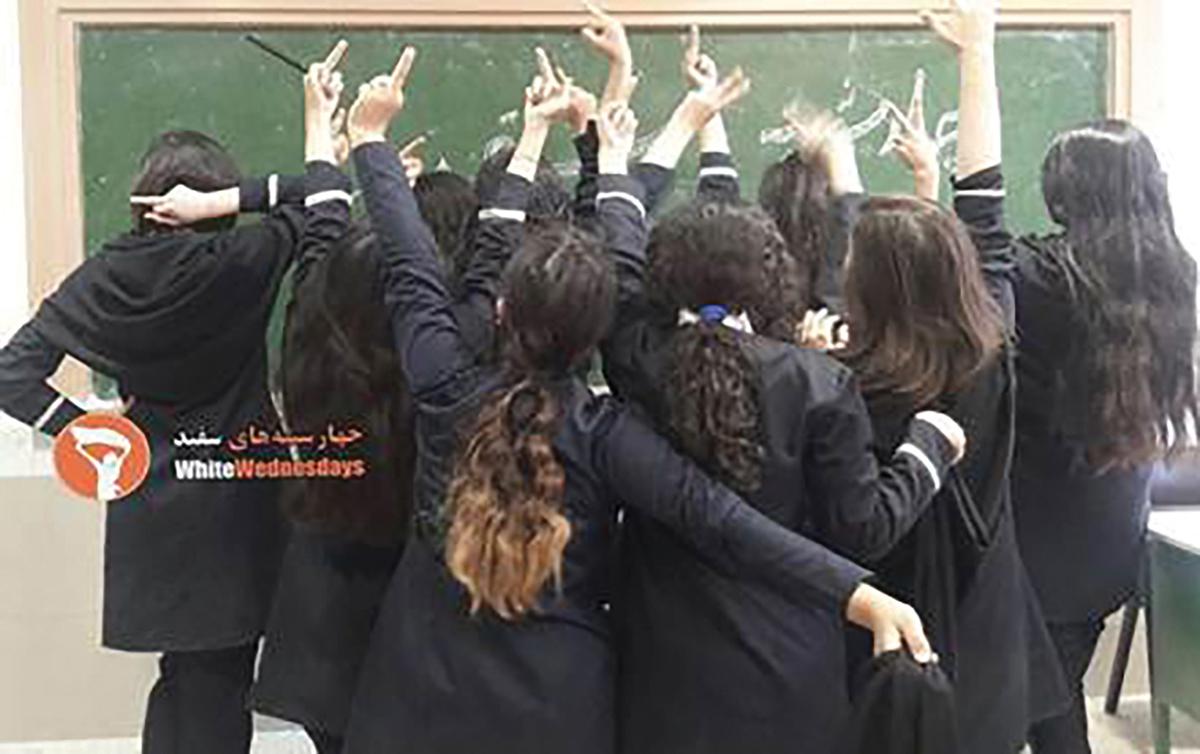
by Parichehr Kazemi, PhD Candidate, Department of Political Science
In 2014, Masih Alinejad, an exiled Iranian journalist, posted on Facebook an image of herself running through a London street with her curly locks lifted in the air, captioning it: “When I run and feel the wind in my hair, I am reminded that I come from a country which kept my hair hostage for thirty years” (Mohseni, 2015). Little did Alinejad know at the time, this small, subversive act to reclaim agency in her new home would pave the way for thousands of Iranian women to do the same, but in the context of a regime bent on restricting them at every turn.
Since Alinejad’s post, countless Iranian women and girls have defied Iran’s strict hijab mandate by taking photos and videos of themselves unveiled in public spaces. From crowded parks to desolate beaches, bustling markets to colorful playgrounds, and state-controlled classrooms to religiously defined prayer sites and holy places, Iranian women are redefining the norms of compliance and bringing feminist activism to the forefront of the public sphere.
Collectively, these photos and videos have launched a social media movement that has grown organically to encompass women’s issues outside hijab laws alone. For example, content often exposes female suppression in gendered spaces where women are prohibited from enjoying the same privileges as men. While Iranian men are free to enter soccer stadiums, ride bicycles, and sing and dance in public, Iranian women are not. Hence, images and videos often reflect confrontations between activists and authorities who recognize a duty to keep women safe from unwanted attention by keeping them away from, or at least contained in, spaces where their bodies could provoke the male gaze. In other instances, content illustrates the social and economic burdens that women disproportionately bear from fines, impounded vehicles, legal charges, and laws that limit opportunities for advancement. Many images and videos even reflect the harassment these women face as a result of their activism, often documenting male (and female) aggressors who take it upon themselves to uphold the law by forcing, and often shaming, women into obedience.
The women who comprise Iran’s “My Stealthy Freedom” movement are therefore brave, defiant, and united in their conviction to resist existing gender injustices. Their unique initiative has not only brought international awareness to the gendered politics of Iran, but has simultaneously uncovered the Islamic Republic’s sensitive spot for keeping and maintaining ideological control. As my research shows, the regime has gone to great lengths in quelling the movement’s momentum. The activists arrested in connection with “My Stealthy Freedom” have been handed hefty prison sentences under trumped-up charges that earlier women’s activists did not face. In one extreme example, a woman received a sixteen-year sentence for handing out flowers in the Tehran metro on International Women’s Day, and in another, a lawyer representing several activists was given a thirty-eight-year prison sentence under charges of collusion, spreading propaganda, and insulting Iran’s supreme leader. To supplement its forceful repression of female activists, the regime has also launched several propaganda campaigns to denounce the movement while promoting its own ideological positions on women. On the one hand, authorities have used state-controlled media to depict Alinejad as a Western spy bent on destabilizing the Islamic Republic. On the other hand, countercampaigns show an attempt to reassert control of the female body by depicting it as a holy and precious site in need of the hijab’s protection to ensure its sanctity.
To fully appreciate the significance of such countermeasures and the issues which “My Stealthy Freedom” has brought to the surface, it is necessary to place the movement within the broader history of veiling in Iranian politics. Veiling has been a central concern of Iranian feminist movements because of its symbolic power in Iranian society. As others have pointed out (Moghissi, 1996; Sedghi, 2007), the Iranian Woman has become the site of contestation between multiple factions who all seek to consolidate their power through their control of the female body. From Iran’s early-modern history to the arrival of Ayatollah Khomeini in Iran, “women’s rights” have, therefore, been the subject of a tense political battle, and the hijab has constituted the symbolic determinacy of who possesses power. This can be seen in Reza Shah’s forced unveiling policy in the 1930s portrayed as a move to “emancipate” women, despite its broader tactical significance for disempowering the clergy, and Khomeini’s “re-emancipation” of their bodies from Western influence, despite its significance as a signaling device to other factions seeking power following the 1979 revolution (Shirazi, 2018). While the former placed women’s bodies at the center of an agenda to Westernize and modernize Iran, the latter placed them at the heart of a plan to Islamicize the country (Childress, 2011).
Key to understanding the significance of “My Stealthy Freedom” is, thus, a history of contention through power dynamics that are seeing their most significant challenge to date from the largest digital movement in Iran (Khiabany, 2015). Central to this impact are the images and videos that comprise the movement. My research approaches them as sites of meaning making where multiple factors converge in visual artefacts to create a unique mode of protest and resistance. Using critical visual theory to disaggregate these artefacts into four component parts that can account for each stage of production, dissemination, and approach, I make a case for the image as a safe space for protest where those who fear the repercussions of an authoritarian state can censor the parts of their bodies that could be used to identify them. In freeing the body from the state’s gaze and yet embodying protest itself, the image simultaneously produces a space for visualizing cultural oppression in some cases, while challenging dominant discourses, reshaping relations, and prefiguring alternative realities in others.
As I move forward with this research, it is my hope to uncover new modes of resistance that can strengthen and advance women’s movements around the world. I am confident that “My Stealthy Freedom” can further illuminate paths in this direction.
—Parichehr Kazemi is a PhD candidate in the Department of Political Science.
REFERENCES
Childress, Diana. Equal Rights Is Our Minimum Demand: The Women’s Rights Movement in Iran. Minneapolis, MN: Lerner Publishing Group, Inc., 2011.
Khiabany, Gholam. “The Importance of ‘Social’ in Social Media: The Lessons from Iran.” In The Routledge Companion to Social Media and Politics, by Axel Bruns, Gunn Enli, Eli Skogerbo, Anders Olof Larsson, and Christian Christensen, 223–34. New York: Routledge, n.d.
Moghissi, Haideh. Populism and Feminism in Iran: Women’s Struggle in a Male-Defined Revolutionary Movement. Second Edition. London: MacMillan Press LTD, n.d.
Mohseni, Ala. “My Stealthy Freedom Documentary, Part 1: A Page Is Born.” IranWire. Accessed May 1, 2020. https://iranwire.com/en/features/1358.
Sedghi, Hamideh. Women and Politics in Iran: Veiling, Unveiling, and Reveiling. Cambridge, Massachusetts: Cambridge University Press, 2007.
Shirazi, Faegheh. “Iran’s Compulsory Hijab: From Politics and Religious Authority to Fashion Shows.” In The Routledge International Handbook to Veils and Veiling Practices, by Anna-Mari Almila and David Inglis, 97–115. New York: Routledge, 2018.

